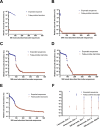Impact of next-generation sequencing error on analysis of barcoded plasmid libraries of known complexity and sequence
- PMID: 25013183
- PMCID: PMC4176369
- DOI: 10.1093/nar/gku607
Impact of next-generation sequencing error on analysis of barcoded plasmid libraries of known complexity and sequence
Abstract
Barcoded vectors are promising tools for investigating clonal diversity and dynamics in hematopoietic gene therapy. Analysis of clones marked with barcoded vectors requires accurate identification of potentially large numbers of individually rare barcodes, when the exact number, sequence identity and abundance are unknown. This is an inherently challenging application, and the feasibility of using contemporary next-generation sequencing technologies is unresolved. To explore this potential application empirically, without prior assumptions, we sequenced barcode libraries of known complexity. Libraries containing 1, 10 and 100 Sanger-sequenced barcodes were sequenced using an Illumina platform, with a 100-barcode library also sequenced using a SOLiD platform. Libraries containing 1 and 10 barcodes were distinguished from false barcodes generated by sequencing error by a several log-fold difference in abundance. In 100-barcode libraries, however, expected and false barcodes overlapped and could not be resolved by bioinformatic filtering and clustering strategies. In independent sequencing runs multiple false-positive barcodes appeared to be represented at higher abundance than known barcodes, despite their confirmed absence from the original library. Such errors, which potentially impact barcoding studies in an application-dependent manner, are consistent with the existence of both stochastic and systematic error, the mechanism of which is yet to be fully resolved.
© The Author(s) 2014. Published by Oxford University Press on behalf of Nucleic Acids Research.
Figures




References
-
- Cavazzana-Calvo M., Hacein-Bey S., de Saint Basile G., Gross F., Yvon E., Nusbaum P., Selz F., Hue C., Certain S., Casanova J.L., et al. Gene therapy of human severe combined immunodeficiency (SCID)-X1 disease. Science. 2000;288:669–672. - PubMed
-
- Gaspar H.B., Parsley K.L., Howe S., King D., Gilmour K.C., Sinclair J., Brouns G., Schmidt M., Von Kalle C., Barington T., et al. Gene therapy of X-linked severe combined immunodeficiency by use of a pseudotyped gammaretroviral vector. Lancet. 2004;364:2181–2187. - PubMed
-
- Gaspar H.B., Cooray S., Gilmour K.C., Parsley K.L., Adams S., Howe S.J., Al Ghonaium A., Bayford J., Brown L., Davies E.G., et al. Long-term persistence of a polyclonal T cell repertoire after gene therapy for X-linked severe combined immunodeficiency. Sci. Transl. Med. 2011;3:97ra79. - PubMed
-
- Aiuti A., Slavin S., Aker M., Ficara F., Deola S., Mortellaro A., Morecki S., Andolfi G., Tabucchi A., Carlucci F., et al. Correction of ADA-SCID by stem cell gene therapy combined with nonmyeloablative conditioning. Science. 2002;296:2410–2413. - PubMed
Publication types
MeSH terms
LinkOut - more resources
Full Text Sources
Other Literature Sources

